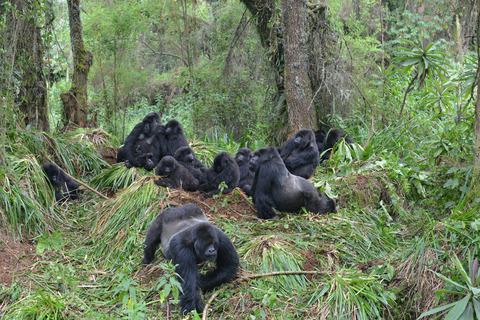当前位置:
X-MOL 学术
›
Anim. Conserv.
›
论文详情
Our official English website, www.x-mol.net, welcomes your feedback! (Note: you will need to create a separate account there.)
Estimating abundance and growth rates in a wild mountain gorilla population
Animal Conservation ( IF 3.4 ) Pub Date : 2020-01-13 , DOI: 10.1111/acv.12559 A.‐C. Granjon 1 , M. M. Robbins 1 , J. Arinaitwe 2 , M. R. Cranfield 3 , W. Eckardt 4 , I. Mburanumwe 5 , A. Musana 6 , A. M. Robbins 1 , J. Roy 1 , R. Sollmann 7 , L. Vigilant 1 , J. R. Hickey 8
Animal Conservation ( IF 3.4 ) Pub Date : 2020-01-13 , DOI: 10.1111/acv.12559 A.‐C. Granjon 1 , M. M. Robbins 1 , J. Arinaitwe 2 , M. R. Cranfield 3 , W. Eckardt 4 , I. Mburanumwe 5 , A. Musana 6 , A. M. Robbins 1 , J. Roy 1 , R. Sollmann 7 , L. Vigilant 1 , J. R. Hickey 8
Affiliation

|
Monitoring population size and growth over time is vital for the conservation of endangered species. Mountain gorillas Gorilla beringei beringei remain in two small populations that span the borders of the Democratic Republic of Congo, Rwanda and Uganda. Each population contains two subpopulations that receive differing levels of protection: the monitored groups are visited daily by park staff and researchers and can be counted by sight, whereas the number and growth rate of unmonitored gorillas must be estimated indirectly. Here, we re-analyze published data from a survey in 2010 combined with new results from a survey conducted during two sampling occasions in 2015 and 2016 to estimate mountain gorilla abundance and growth in the Virunga Massif between 2010 and 2016. Using genetic analysis of non-invasively collected samples and two capture–mark– recapture estimates, we estimated that the 186 detected genotypes represented 221 (95% credible interval: 204–243) to 251 (205–340) unmonitored gorillas in 2016. Together with the 418 monitored gorillas, the overall population of the Virunga Massif thus reached 639 (622–661) to 669 (623–758) individuals. We estimated the growth of the entire Virunga Massif population at about 3% per year, but determined that the growth of the monitored gorillas (4.4%) mainly drove that increase. In contrast, the trend of the unmonitored subpopulation could not be determined with confidence because both models provided 95% CI that encompassed zero: 0.5% per year ( 0.7% to +1.7%) and 1.1% ( 2.7% to +4.4%). While the overall growth rate represents a rare success story for primate conservation, our results highlight the need for greater protection of unmonitored gorillas.
中文翻译:

估计野生山地大猩猩种群的丰度和增长率
随着时间的推移监测种群规模和增长对于保护濒危物种至关重要。山地大猩猩 Gorilla beringei beringei 仍然是跨越刚果民主共和国、卢旺达和乌干达边界的两个小种群。每个种群包含两个接受不同保护级别的亚种群:公园工作人员和研究人员每天都会访问受监控的群体,并且可以通过目测计数,而不受监控的大猩猩的数量和增长率必须间接估计。在这里,我们重新分析了 2010 年一项调查的已发布数据,并结合 2015 年和 2016 年两次抽样调查的新结果,以估计 2010 年至 2016 年维龙加地块的山地大猩猩丰度和增长。使用非侵入性收集的样本的遗传分析和两个捕获-标记-重新捕获估计,我们估计 186 个检测到的基因型代表 221(95% 可信区间:204-243)到 251(205-340)只 2016 年未监测的大猩猩。有了 418 只被监测的大猩猩,维龙加地块的总种群数量因此达到了 639 (622-661) 至 669 (623-758) 只个体。我们估计整个维龙加地块种群的年增长率约为 3%,但确定受监控的大猩猩 (4.4%) 的增长主要推动了这一增长。相比之下,无法确定未监测亚群的趋势,因为两种模型都提供了 95% 的 CI,其中包含零:每年 0.5%(0.7% 至 +1.7%)和 1.1%(2.7% 至 +4.4%)。
更新日期:2020-01-13
中文翻译:

估计野生山地大猩猩种群的丰度和增长率
随着时间的推移监测种群规模和增长对于保护濒危物种至关重要。山地大猩猩 Gorilla beringei beringei 仍然是跨越刚果民主共和国、卢旺达和乌干达边界的两个小种群。每个种群包含两个接受不同保护级别的亚种群:公园工作人员和研究人员每天都会访问受监控的群体,并且可以通过目测计数,而不受监控的大猩猩的数量和增长率必须间接估计。在这里,我们重新分析了 2010 年一项调查的已发布数据,并结合 2015 年和 2016 年两次抽样调查的新结果,以估计 2010 年至 2016 年维龙加地块的山地大猩猩丰度和增长。使用非侵入性收集的样本的遗传分析和两个捕获-标记-重新捕获估计,我们估计 186 个检测到的基因型代表 221(95% 可信区间:204-243)到 251(205-340)只 2016 年未监测的大猩猩。有了 418 只被监测的大猩猩,维龙加地块的总种群数量因此达到了 639 (622-661) 至 669 (623-758) 只个体。我们估计整个维龙加地块种群的年增长率约为 3%,但确定受监控的大猩猩 (4.4%) 的增长主要推动了这一增长。相比之下,无法确定未监测亚群的趋势,因为两种模型都提供了 95% 的 CI,其中包含零:每年 0.5%(0.7% 至 +1.7%)和 1.1%(2.7% 至 +4.4%)。



























 京公网安备 11010802027423号
京公网安备 11010802027423号